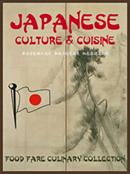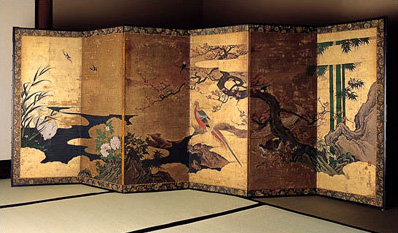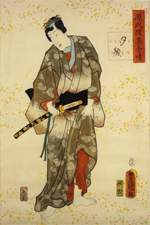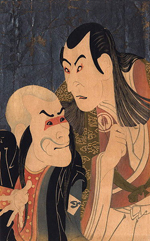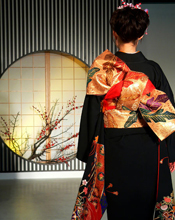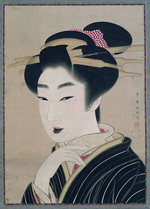|
Contents:
More:
E-book edition of "Japanese Culture & Cuisine" >
|
Japanese Culture
Similar to most ancient nations, Japan's culture has evolved in great measures from the Stone Age to the present. Their culturally rich society has much to offer the rest of the world, including unique insights into structural and garden architecture, cuisine, education, language, performing and visual arts, literature and technology. There are a variety of building styles in Japan. Temple-building in Japan began in earnest after Buddhism was introduced in the 6th century. Most structures were built using wood, with emphasis placed on gravity (slanted roofs), horizontals, simplicity and sparse ornamentation. Today, Japan contains an appealing mixture of ancient and modern architectural design. Steel and concrete are used in conjunction with wood, especially in highly-populated urban areas such as Tokyo and Osaka. Simplicity and modernism are key elements in Japanese interior design, which is derived from Zen Buddhism and Taoism ("aesthetic ideal of emptiness"). In private homes, impermanence is common. Sliding walls, decorative rice-paper screens (shoji), and storage cupboards that appear to blend into walls are unique aesthetics of Japanese interior design. Rooms considered important are often given an extra touch in the form of a tokonoma, an alcove used for displaying flower arrangements or objects of art.
Other common design elements include formal entryways (genkan), staggered shelves (chigai-dana), tatami mats on floors and verandas (engawas) built between living quarters and gardens. Exterior walls can also be opened during mild weather to bring in sunshine and breezes, and to permit views of the garden. Imperfections are also appreciated. Examples of the diversity found in Japanese architecture can be found at Kirin Plaza in Osaka, Kobe Port Tower, Yamanashi Fruit Museum, the Dior Store in Shibuya (Tokyo) and the Twenty-Six Martyrs Museum & Monument in Nagasaki. Ancient architecture examples are still in evidence in the many surviving pagodas and temples, such as Kinkaku-ji (Temple of the Golden Pavilion) in Kyoto, Arahakasan Shitenno-ji in Osaka, Great Buddha Hall (Daibutsuden) in Nara, and the Three Mountains of Dewa (Dewa Sanzan), which is a five-storied pagoda located near the base of Mount Haguro. Japan's education system played a crucial role in their economic recovery after World War II. Since 1947, education levels have consisted of six years in elementary school (Shogakko), three years in junior high (Chugakko), three years of high school (Kotogakko), and at least two to four years at university (Daigaku). Some children also attend kindergarten (Yochien). According to World University Rankings (2018), Japan has three schools which rank in the top one hundred of universities around the globe. The schools include the University of Tokyo, Kyoto University and Nagoya University. The Japanese language (Nihongo) is spoken by more than 130 million people worldwide. As with any language, there are several dozen dialects spoken in different regions, prefectures and cities in Japan. All are part of the Japonic language family, which emphasizes small sounds, pitch-accents, agglutinative verb morphology and an elaborate system of honorifics (keigo). Stand-alone words are also categorized. For example, word classes with inflections (known as katsuyogo) include verbs (doshi) as well as "i" and "na" adjectives (keiyoshi and keiyodoshi respectively). Word classes without inflections are nouns (meishi), pronouns (daimeishi), adverbs (fukushi), conjunctions (setsuzokushi), interjections (kandoshi) and prenominals (rentaishi). The Japanese language is simple yet elegantly beautiful, with dichotomous guttural-soft pitches.
Other notable books and authors include Kokin Wakashu, a poetry anthology written by four court poets and published in 914; Makura no Soshi (1002, also known as "The Pillow Book") by Sei Shonagon; Tsurezuregusa (1332, "Harvest of Leisure") by the Buddhist monk Yoshida Kenko; the travel diary Oku no Hosomichi (1702) by Matsuo Basho; Botchan and Kokoro (1914) by Natsume Soseki; Suna no Onna (1962, "The Woman in the Dunes") by Kobo Abe; and Kojinteki na Taiken (1964, "A Personal Matter") by Kenzaburo Oe. Well-known contemporary authors include Haruki Murakami and Banana Yoshimoto. Japanese music (ongaku) has many traditional and modern distinctions, and follows only second to the United States as being the largest music market in the world. Court orchestras (shomyo) are one of the oldest known forms of music in Japan, which included Buddhist chanting and Gagaku ("elegant" classical). Musical theater (noh) developed in the 14th-century, brought to popularity by the famed musicians Kan'ami and Zeami. Folk music was often performed using short-necked lutes (biwa) to tell a story, while Taiko (drumming) was used to highlight a variety of music genres. In modern times, western influence was felt in the composition of Auld Lang Syne, which was written by a politician named Izawa Shuji based on a poem by the Scottish poet Robert Burns. Pop music (kayokyoku) developed in the 1900's. One of the first best-selling records in Japan was the Kachusha no Uta (1914), sung by Sumako Matsui. Other singers, such as Misora Hibari and Kiyoshi Hikawa, popularized a form of music known as enka (a mixture of traditional and modern). Western classical, hip-hop, jazz and rock music are also prevalent in Japan. Some of the more well-known artists include Aburadako (punk rock), Dabo (hip-hop), Dragon Ash (rock), Ayumi Hamasaki (disco), Yosui Inoue (folk-rock), Seiji Ozawa (classical orchestra conductor), Kazuki Tomokawa (alternative rock), Sadao Watanabe (jazz), Akiko Yano (electro-pop), among many others.
Pictured at right: Painting of Kabuki actors Bando Zenji and Sawamura Yodogoro II in the play Yoshitsune Senbon-Zakura (Yoshitsune of the Thousand Cherry-Trees) from 1794. Click on image to view larger size in a new window. Japanese visual art covers a wide range of categories, such as calligraphy, lacquer, painting, pottery, prints and sculptures. Just a few of the more famous artisans include Yosa Buson (poet and painter who developed the nanga style of painting), Hidari Jingoro (painter, sculptor and carver; well known for his work at the Nikko Tosho-gu Shinto shrine in Nikko), Kose Kanaoka (painter who adopted Chinese styles and methods during the T'ang Dynasty), Jochu (sculptor who made popular the yosegi technique of carving one figure from multiple wood pieces), Hamada Shoji (potter who was declared a National Living Treasure in 1955), and Hishikawa Moronobu, known as "father" of the Ukiyo-e wood-blocking style (pictures of the floating world). Baseball is the most popular sport in Japan. It was first introduced in 1872, with the first team (Shimbashi Athletic Club) being established six years later. More traditional sports include the martial arts (koryu), which offers a variety of techniques such as gendai budo, judo, jujutsu, kenjutsu, kyudo, sojutsu and sumo among others. Sumo wrestlers (rikishi) are considered to be in the gendai budo class. Boxing, figure skating, football, golf, handball, motor racing, rugby and professional wrestling (Puroresu) are also favored spectator sports in Japan. Japan is one of the leading nations in science and technology, in particular electronics, medical research, robotics and the automotive industry. Their allotment of research dollars is a staggering $130 billion each year, with more than 650,000 researchers working in various fields. The most well-known electronic and computer-related product names include Canon, Epson, Fuji, Fujitsu, Hitachi, NEC, Panasonic, Sharp, Sony and Toshiba. Japanese car manufacturers and other transport vehicles are perhaps the most famous in the world: Datsun, Honda, Lexus, Mazda, Mitsubishi, Nissan, Subaru and Toyota, among others. Japan also leads the pack in chemical production, machinery, nuclear energy, optics, semi-conductors and space rockets.
Other traditional clothing includes Fundoshi (loincloth that was once an undergarment for men), Geta (elevated sandals), Hakama (pleated pants or skirt worn over a kimono), Hiyoku (robe worn under outer kimono), Jikatabi (boots in the shape of tabi socks; mostly worn by construction and farm workers), Kanzashi (seasonal hair ornaments), Nagajuban (robe worn under a kimono, similar to underwear), Obi (sashes worn at the kimono waist), Okobo (wooden platform sandals), Tabi (buckled socks worn with sandal shoes, the big toe separated), Uchikake (robe worn as a coat over bridal kimonos), Yukata (summer robe similar to a kimono that is often worn for public events) and Zori (formal sandals), among many others. Dresses worn during traditional Japanese wedding ceremonies are often colored white, with the bride wearing a wataboshi headdress made from silk (also known as tsunokakushi or "demon horns"). The headdress typically drapes over the bride's face, which signifies her concealment of jealousy and submission to her mother-in-law. Brides also adorn tabi and zori, which are short white stockings and clogs, along with an obi, a belt that encircles the waist and cinches the kimono together. Grooms might wear a black montsuki haori, the male version of a kimono with a coat and sash tucked into leg-split baggy pants known as hakama. Outfits worn by the couple are supposed to be a contrast, with the bride in white and the groom in black. Typical wedding feast dishes include Adzuki beans and rice, the beans meant to signify good fortune. There might also be asari clams steamed with sake, salt and water to symbolize togetherness; steamed lobster for luck, and herring roe to bring fertility. The reception is known as Kekkon Hiroen. The father of the bride will give the kanpai, which is the first toast. After the new husband and wife change out of their wedding attire, they'll perform what is known as the candle service. They will go to their parents and light a quince candle, and then walk around the room in a circle and light other candles. At wedding rehearsals, mothers often lower their veils to signify the last act a mother can do for her daughter before giving her away to her new husband. There are two types of Shinto wedding ceremonies. Miai is an arranged marriage, while ren'ai is a love match. At some point during a ceremony, the bride and groom will drink from three sake cups, which are all different sizes from small to large, and take three sips from each cup. The ritual is called sansankudo, and is supposed to symbolize their union as husband and wife.
"Pleasure quarters" were established in the 16th-century, where Geisha performed erotic dances and skits, played music and sang. The art was dubbed kabuku, which eventually became known as an early form of Kabuki Theater. Later, Geisha became much more than licensed courtesans. By the year 1800, being a Geisha was considered a valid occupation. Many confuse Geisha with prostitutes. However, Geisha considered legitimate do not engage in paid sex with clients. Their goal is to merely entertain with conversation, poetry-reading, dancing or playing musical instruments. There are various stages of dress during a Geisha career. Hairstyles, eyebrow length, cosmetics and kimono styles are all factors which indicate the maturity level of a specific Geisha. Typical cosmetic array includes a white rice-powder base painted on the face, along with red lipstick and black accents around eyes and brows. Novice Geisha wear colorful kimonos, while older, more mature Geisha don subdued patterns and fewer cosmetics. The Shimada hairstyle is common for most Geisha, which involves four major types: taka shimada (high chignon worn by younger women), tsubushi shimada (flattened chignon worn by older women), uiwata (chignon bound with colored crepe) and maiko (split-peach style only worn by apprentices). Geisha must be single. If they decided to marry, they must retire the profession. Some Geisha also move on to establish their own Okiya (Geisha house), or simply retire after repaying the financing of their Geisha education.
Christmas is a fairly new holiday celebration in Japan, which started at the beginning of the 20th century. Oddly enough, the Japanese became acquainted with the Christmas holiday because of various products they manufactured for other countries for the holiday season. As only about one percent of Japan's population is Christian, Christmas is mainly about decorating, gift-giving and doing for others. For most Japanese people, Christmas is celebrated as a holiday devoted to the love of their children. Cities are now decorated. Tinsel and lights are displayed in cafes and dance halls. Trees are adorned with small toys and paper ornaments made of gold, wind chimes and lanterns. The most popular decoration in Japan is the "origami" Swan. Christmas is the time of year when most Japanese people do things for others. Hospitals are decorated to lift spirits, and children sing carols to patients. Children call Santa "Santa Kurohsu" because he is believed to have eyes in the back of his head so he can watch children all through the year. Also known as "Hoteiosho" (a god in Japanese culture), Santa brings gifts every year on Christmas for the children. Many parties are held in Japan around Christmas, with December being known as the "bounenkai" (forget-the-year) season. There is also the custom of sending "Oseibo" (end-of-the-year-gift) from business to business. The "business" gifts can consist of beer, fruit, coffee or hams. "Oseibo" are specifically given to pay back favors received during the year.
• Next: Japanese Food History >
|


